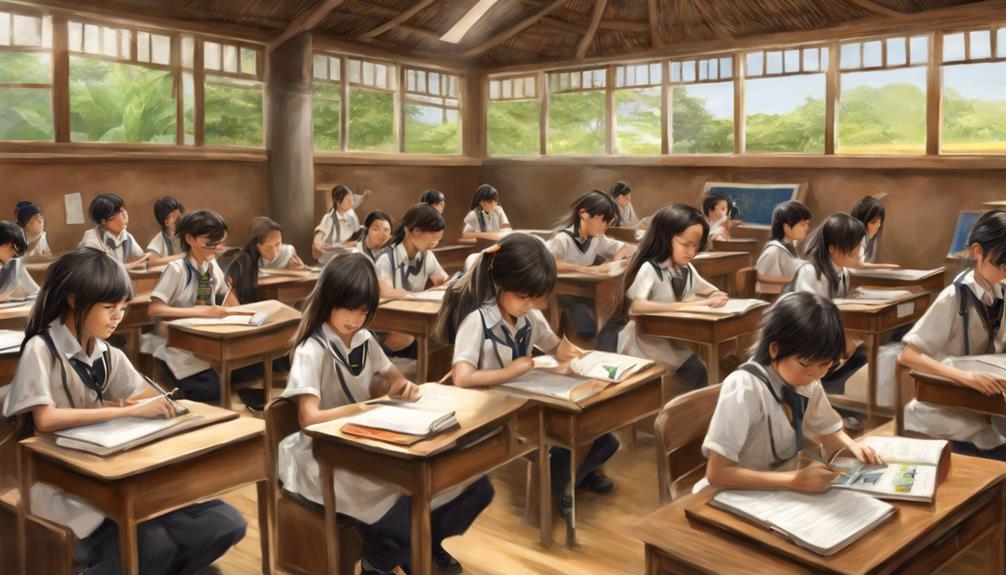Schools across the globe serve as microcosms of each society's unique values and priorities, shaping the future generation's worldview and skill set. From the rigorous memorization techniques in Chinese schools to the moral education emphasis in Japanese institutions, each country offers a distinct approach to fostering knowledge and character. The intriguing diversity in schooling practices worldwide prompts a critical examination of how these varying methods impact students' academic success and societal contributions, hinting at a fascinating journey through the global educational landscape.
Key Takeaways
- Educational systems reflect diverse cultural values and approaches worldwide.
- Schools worldwide vary in emphasis on individualized vs. standardized learning.
- Religious influence shapes educational practices and societal values in different countries.
- Financial aspects impact access to quality education and resources globally.
Chinese Emphasis on Memorization
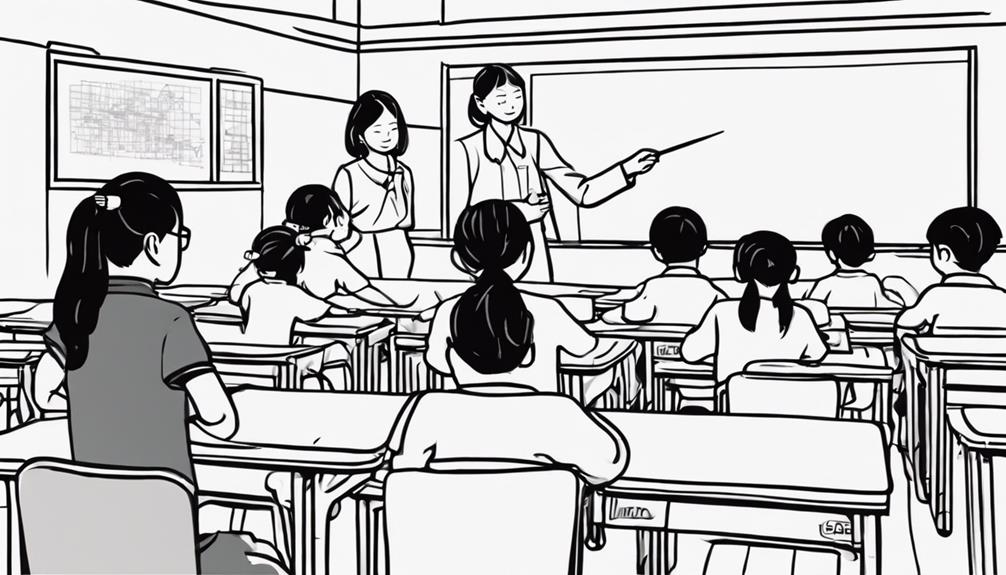
In Chinese education, a significant emphasis is placed on the practice of memorization and rote-learning as fundamental strategies for learning. Chinese schools prioritize the early acquisition of vast amounts of information as a cornerstone of their educational approach. Students are expected to memorize extensive content across various subjects, with the belief that this process lays the groundwork for a strong academic foundation. The memorization of facts and figures is particularly crucial in preparing students for high-stakes exams like the Gaokao, which heavily influence their future academic and professional paths. Mastery of memorization techniques is not only encouraged but deemed essential for achieving academic success within the Chinese education system. This focus on rote-learning reflects a cultural belief in the value of discipline, hard work, and persistence in the pursuit of knowledge and educational attainment.
French Ban on Religious Dress
The enforcement of a ban on religious dress in French schools underscores the nation's staunch commitment to secular principles and the maintenance of a neutral educational environment. French schools uphold secularity by prohibiting the display of religious symbols such as hijabs, kippahs, and large crosses in public educational institutions. This ban on religious dress is implemented to create a uniform and inclusive environment for all students, promoting equality and preventing any form of religious discrimination. French law strictly prohibits students and staff from wearing conspicuous religious symbols in school settings, reflecting the country's dedication to secularism and the separation of religion from public institutions. By upholding this ban, French schools aim to ensure that all individuals, regardless of their religious beliefs, can learn and interact in a neutral and inclusive educational environment that respects the diversity of its student body.
Dominance of Catholic Schools in Ireland
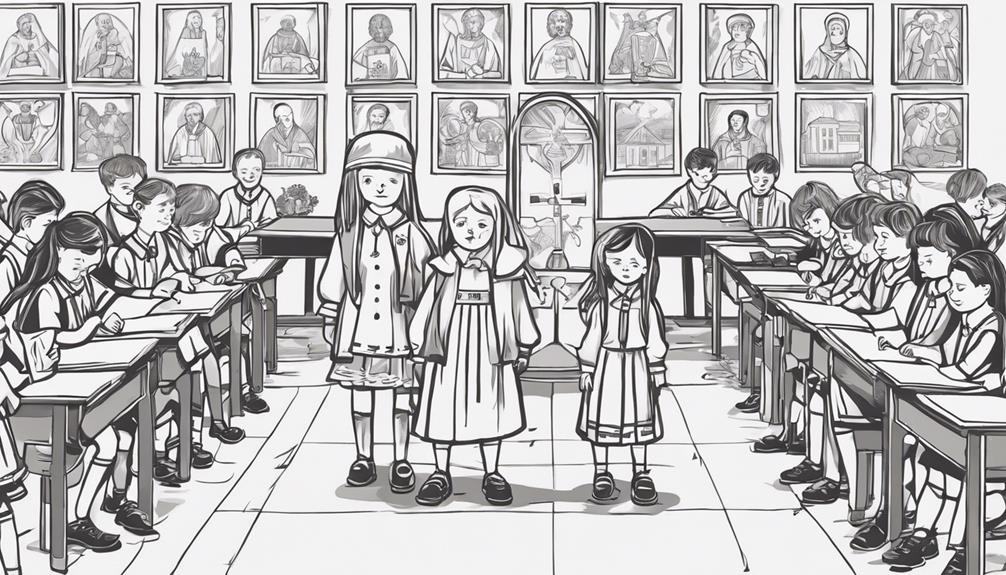
The prevalence of Catholic schools in Ireland has a profound impact on society, shaping not only the educational landscape but also the cultural and religious fabric of the country. These institutions play a pivotal role in instilling moral values and religious teachings in students from a young age, contributing to the overall moral development of individuals within the Irish society. The dominance of Catholic schools underscores the enduring influence of the Catholic Church in Ireland, reflecting a historical connection between education and religion in the country.
Catholic Education in Ireland
Despite the secular modernization trend in many countries, the pervasive influence of Catholic education in Ireland remains deeply ingrained within the educational framework. Catholic schools dominate the education system in Ireland, with the majority of primary and secondary schools being Catholic-affiliated. Enrollment often involves baptism, highlighting the close connection between education and religion in Ireland. The Catholic Church plays a significant role in shaping the curriculum and ethos of these schools, with government funding supporting their operations. Beyond academics, Catholic education in Ireland also emphasizes moral and religious teachings, contributing to the holistic development of students. This enduring presence of Catholic schools underscores their importance in shaping the educational landscape and societal values in Ireland.
Impact on Society
Amidst the educational landscape of Ireland, the pervasive presence of Catholic schools significantly influences societal values and cultural norms. This dominance of Catholic schools in the country's education system has far-reaching implications on society:
- Cultural Influence: The prevalence of Catholic schools reinforces the cultural influence of the Catholic Church, shaping the values and beliefs of students and communities.
- Moral Education: Catholic schools play a crucial role in providing moral education based on Catholic teachings, impacting the ethical development of students and contributing to societal values.
- Societal Impact: The strong presence of Catholic schools not only affects individual students but also has broader societal implications, influencing the overall fabric of Irish society through the promotion of Catholic principles and traditions.
Unique Bangladeshi Schooling on Boats
In response to the challenges posed by flooding in Bangladesh, unique boat schools have been established to ensure uninterrupted access to education for children in affected regions. These boat schools operate in flooded areas, providing a vital educational lifeline for children who would otherwise be unable to attend traditional schools due to the environmental obstacles caused by frequent flooding. The concept of boat schools in Bangladesh represents an innovative approach to overcoming the challenges of delivering education in flood-prone regions. By offering continuous learning opportunities, these floating schools play a crucial role in ensuring that children have access to education regardless of the circumstances.
| Benefits of Boat Schools in Bangladesh | Emotions Evoked |
|---|---|
| Continuous access to education | Hope |
| Innovative solution to environmental challenges | Resilience |
| Ensuring learning despite flooding | Determination |
| Equal educational opportunities | Empathy |
Moral Education in Japanese Schools
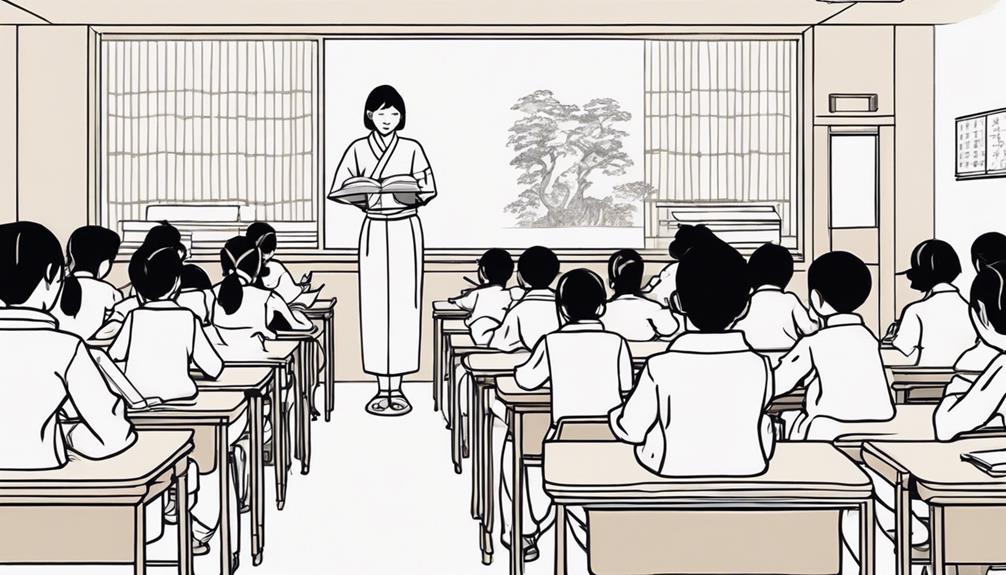
Moral education in Japanese schools stands out for its emphasis on instilling values like respect, responsibility, and harmony. The curriculum not only focuses on cultivating virtues such as empathy, honesty, and good citizenship but also includes teaching ethics, social norms, and moral dilemmas. Moreover, Japanese schools actively engage students in activities like school cleaning to foster a sense of responsibility and community.
Values Taught in Japan
How are values like respect, responsibility, and harmony instilled in Japanese schools through moral education?
- Emphasis on Respect: Japanese schools teach students to respect others, including their teachers, peers, and the environment. This fosters a culture of mutual respect and appreciation for diverse perspectives.
- Development of Responsibility: Moral education in Japan instills a sense of responsibility in students towards their actions and the impact they have on the community. Students are encouraged to take ownership of their behaviors and decisions.
- Promotion of Harmony: Japanese moral education focuses on the importance of harmony within groups. Students learn to prioritize the collective well-being over individual interests, promoting social cohesion and teamwork.
Classroom Ethics in Japan
Have Japanese schools successfully implemented classroom ethics as a cornerstone of moral education, fostering character development and ethical decision-making among students? In Japan, moral education is a fundamental aspect of the school curriculum, emphasizing values such as respect, discipline, and harmony. Classroom ethics in Japanese schools are designed to cultivate good citizenship and social responsibility by instilling a strong sense of moral values in students. Teachers play a crucial role in modeling ethical behavior and guiding students towards making ethical decisions. The moral education curriculum in Japan includes teachings on empathy, honesty, and consideration for others, aiming to develop students' character and encourage them to act with integrity and compassion in their interactions with others.
Cultural Morality Lessons
Cultural morality lessons in Japanese schools play a pivotal role in shaping students' understanding of societal values and fostering a sense of community responsibility.
Key Aspects of Moral Education in Japanese Schools:
- Emphasis on Values: Japanese schools prioritize instilling values such as respect, discipline, and responsibility in students through moral education.
- Focus on Ethics: Moral lessons in Japan go beyond theoretical teachings to include practical aspects like ethics, honesty, and empathy.
- Promotion of Social Harmony: The overarching goal of moral education in Japanese schools is to cultivate a sense of social harmony and community responsibility among students.
Paid Education in South Africa
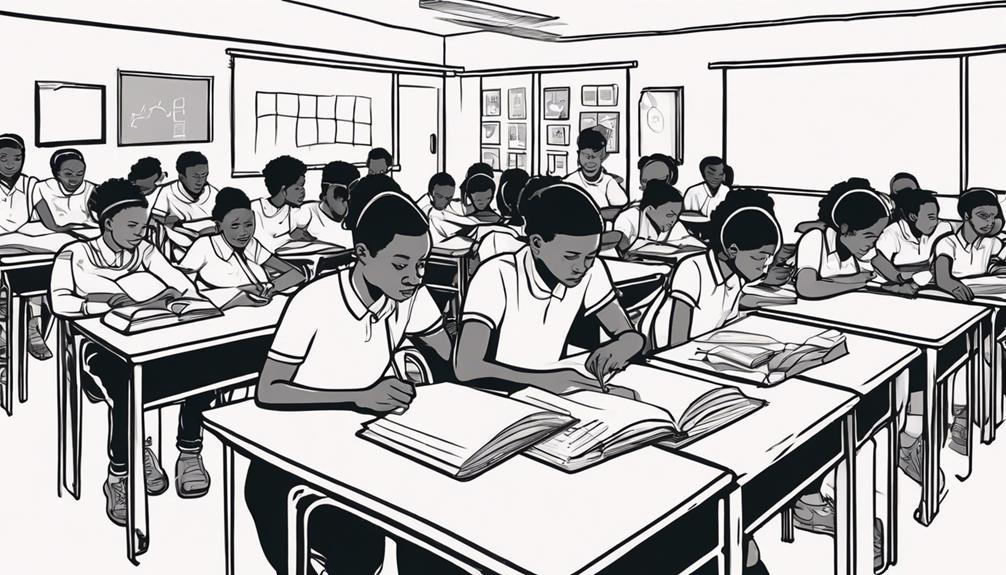
Examining the financial contributions made by parents towards education in South Africa reveals a system characterized by paid education. School fees play a significant role in funding education in South Africa, leading to disparities in access to quality education. The varying levels of school fees across different institutions contribute to unequal educational opportunities for students. This situation underscores the challenges faced in ensuring educational inclusivity and affordability in the country.
The payment of school fees not only impacts students and their families but also affects the resources available to schools. Schools with higher fee structures may have more resources, while those with lower fees might struggle to provide quality education. To address the issue of financial barriers to education, some schools in South Africa offer scholarships or financial aid to students in need. These initiatives aim to bridge the gaps in access to education and promote inclusivity within the educational system. Overall, the issue of paid education in South Africa highlights the importance of addressing disparities in educational opportunities to ensure a more equitable system for all students.
Opposition to Uniforms in German Schools
The absence of uniform regulations in German schools fosters a culture of individuality and personal expression among students, contrasting with the paid education system prevalent in South Africa. This lack of uniform rules in German schools reflects a cultural emphasis on personal freedom and self-expression. Students in German schools have the liberty to choose their attire, promoting diversity and creativity within the school environment. This approach aligns with the country's values of individualism and respecting personal choices.
Key Points:
- Promotion of Individuality: The absence of uniform requirements allows students to showcase their individuality through their clothing choices.
- Cultural Emphasis on Personal Freedom: German schools prioritize personal freedom and self-expression over uniformity.
- Encouragement of Creativity: The freedom to choose attire fosters creativity among students and contributes to a diverse school environment.
Extended School Days in South Korea
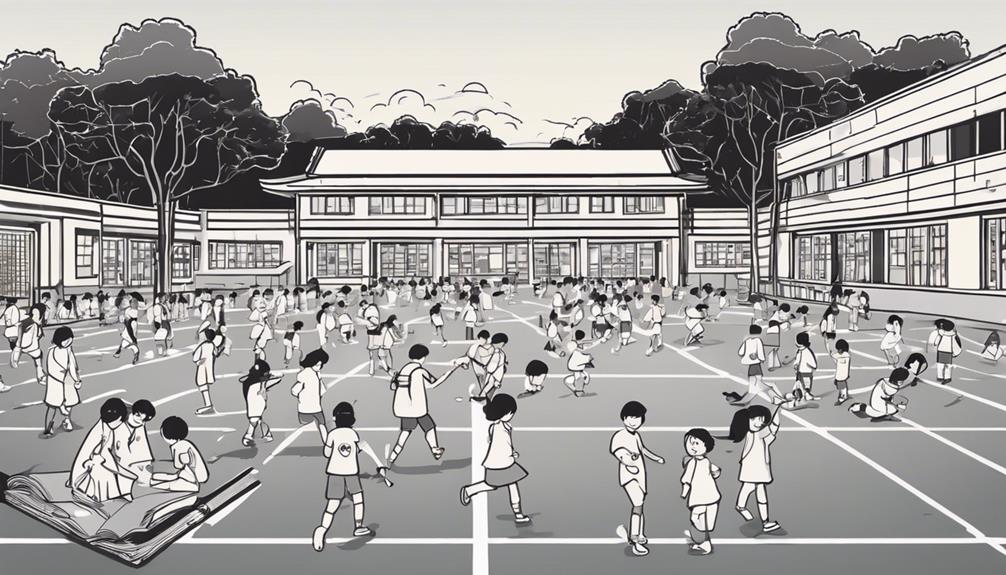
South Korea's extended school days, lasting up to 16 hours, are a defining feature of the country's education system, emphasizing a strong commitment to academic excellence and hard work. South Korean students experience a heavy academic workload, leading to rigorous study schedules that contribute to their success. The intense focus and dedication to studies among South Korean students result in high levels of academic achievement. Private schools in South Korea play a significant role in offering intensive revision programs to support students in their academic endeavors through these extended hours of schooling. The emphasis on long school days in South Korea reflects the cultural value placed on hard work and the importance of academic success within the education system. Overall, the extended school days in South Korea are integral to shaping the educational experiences of students and are closely linked to the nation's emphasis on academic excellence and dedication to learning.
Dutch Schooling Start Age
The age of enrollment, schooling structure, and curriculum differences in Dutch schools are key points of interest when considering the impact of starting school at age 4. Analyzing how these factors interact can provide insights into the effectiveness of the Dutch educational system in fostering early childhood development. By examining these aspects, we can better understand the rationale behind the Netherlands' approach to initiating formal education at a young age.
Age of Enrollment
Commencing formal education at the age of four in the Netherlands emphasizes early educational engagement to facilitate a seamless transition into the schooling system. This approach has several benefits:
- Minimizing Developmental Gaps: Starting school early helps reduce developmental disparities among children, ensuring a more level playing field.
- Fostering Positive School Routines: Young students in the Netherlands have the opportunity to adapt to school routines gradually, leading to a smoother adjustment period and enhancing the overall learning experience.
- Building a Strong Foundation for Academic Success: The emphasis on early education in the Dutch schooling system aims to establish a solid basis for future academic achievements, setting students on a path towards success.
Schooling Structure
Starting formal education at the age of four in the Netherlands reflects an educational framework that prioritizes early academic engagement and lays a foundational structure for students' learning journey. The Dutch schooling system's emphasis on early education aims to minimize developmental gaps among students by providing them with an early start. By starting school at a younger age, Dutch students have more time to adjust to the school environment and enhance their socialization skills with peers. This early school entry aligns with a holistic approach to child development, recognizing the importance of initiating educational experiences at a young age to support overall growth and learning. The schooling structure in the Netherlands underscores the significance of early academic involvement in shaping students' educational paths within their education systems.
Curriculum Differences
Embarking on formal education at the age of four in the Netherlands initiates a structured approach to academic engagement and social development, setting a distinctive trajectory for students' educational journeys. This early start promotes holistic development and lifelong learning by focusing on the following aspects:
- Reduction of Developmental Gaps: Commencing education at a young age helps minimize developmental disparities among students, laying a more equitable foundation for future academic progress.
- Facilitation of Social Interaction: Starting school at four provides Dutch students with ample time to adjust, fostering the opportunity to make friends and develop crucial social skills essential for their overall growth.
- Emphasis on Early Education: The emphasis on early education in the Netherlands aligns with the country's commitment to holistic development, ensuring that children receive a comprehensive educational experience from the outset.
Norwegian High School Graduation Tradition
The Norwegian high school graduation tradition encompasses a three-week celebration marked by a series of elaborate festivities and customs, culminating in a significant rite of passage for students completing their secondary education. During this period, students participate in 'russefeiring,' donning colorful overalls and transforming buses for celebratory purposes. The graduation celebration, known for its vibrant spirit, signifies the conclusion of secondary education and holds immense cultural importance in Norway.
| Aspect | Description |
|---|---|
| Festivities | Parades, concerts, and elaborate parties are common activities during the period. |
| Traditions | Students engage in various traditional customs throughout the three-week event. |
| Rite of Passage | The celebration serves as a crucial rite of passage for Norwegian high schoolers. |
| Russ Hats | The festivities culminate in a ceremony where students are bestowed with 'russ' hats. |
| Russefeiring | 'Russefeiring' involves students celebrating with exuberance and camaraderie. |
Varied Approaches to Education Worldwide
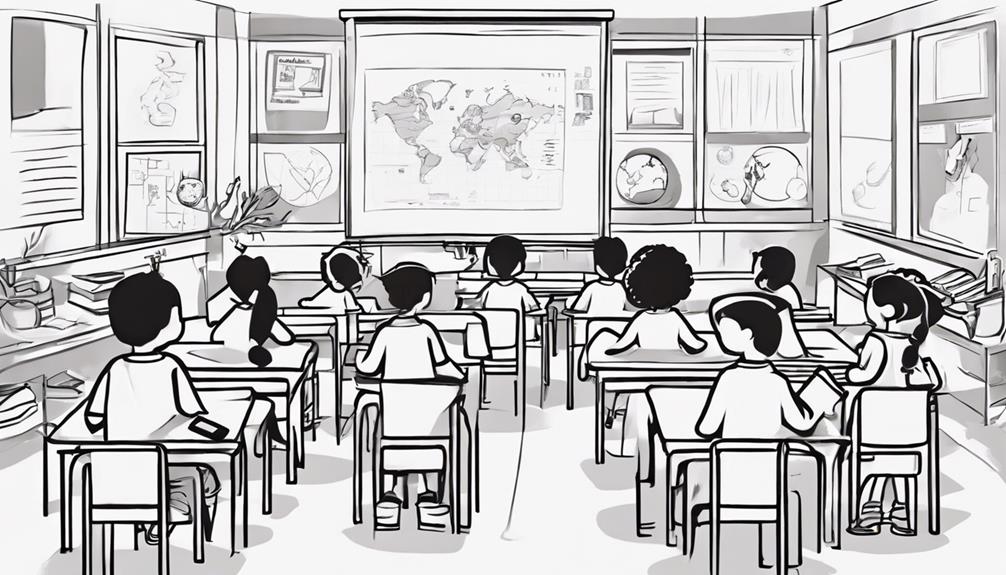
Variances in educational methodologies worldwide exhibit distinct approaches that reflect diverse cultural values and societal priorities. When comparing educational systems across different countries, several key differences emerge:
- Emphasis on Individualized Learning: While some countries like Finland prioritize individualized learning methods tailored to each student's needs, others such as China focus on memorization and standardized testing, emphasizing a more uniform approach to education.
- Integration of Cultural Aspects: Educational systems in countries like Japan place a strong emphasis on moral education and instilling societal values in students, reflecting the importance placed on cultural norms and traditions in the learning process.
- Social Norms and Inclusivity: Brazilian schools stand out for their emphasis on social and emotional learning, diversity, and inclusion. This focus highlights the role of education in promoting social cohesion and addressing societal inequalities within the public school system.
These differences in educational approaches underscore the complex interplay between cultural values, social norms, and the goals of the public education system in shaping the learning experiences of students worldwide.
Frequently Asked Questions
How Is School Different in Other Countries?
In various countries, schools exhibit diverse classroom structures, teaching methods, and student uniform policies. School holidays, lunch programs, extracurricular activities, homework expectations, parental involvement, and technology integration also vary significantly. Understanding these differences contributes to a broader perspective on global education systems, enriching discussions on educational practices and policies worldwide. Each country's unique approach reflects cultural values, educational goals, and societal norms, shaping the learning experiences of students globally.
What Are the Different Education Systems Around the World?
Education systems around the world vary widely in teaching methods, curriculum content, assessment techniques, student discipline, classroom size, teacher qualifications, school facilities, hours, and extracurricular activities. These differences reflect cultural values, societal needs, and educational philosophies. Understanding these variations can provide insights into the effectiveness of different approaches and offer opportunities for cross-cultural learning and collaboration in the field of education.
How Is the US Education System Different From the World?
The US education system differs from many global counterparts in various aspects. Teaching methods prioritize student engagement and critical thinking. Curriculum content often includes a wide range of subjects and electives. Grading systems typically use letter grades. Classroom sizes tend to be larger. School holidays are structured differently. Extracurricular activities are encouraged. School uniforms are not mandatory in most public schools. Technology integration is prevalent. Teacher training programs are rigorous and ongoing.
How Are Schools Different Now Then in the Past?
In recent years, schools have transitioned from a focus on rote memorization and standardized testing to prioritizing critical thinking, creativity, and personalized learning. This shift is accompanied by a strong emphasis on technology integration, collaboration, and communication skills. Curriculum changes reflect a move towards individualized instruction, while assessments now encompass a broader range of evaluation techniques. These advancements aim to cultivate a diverse student body equipped with the necessary skills for the modern world.
Conclusion
In conclusion, the diverse approaches to education worldwide reflect the unique cultural, religious, and societal values of each country. Each educational system offers a distinct perspective on learning and development, shaping the future generations in their own way. As the tapestry of global education systems continues to evolve, it is important to acknowledge and appreciate the rich variety of educational practices that contribute to the global landscape of knowledge and understanding.
"The diverse approaches to education worldwide paint a vivid picture of the rich tapestry of global learning."
